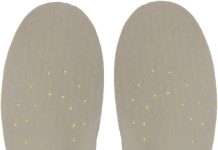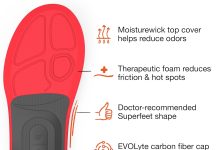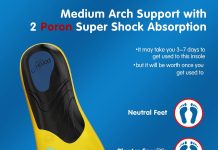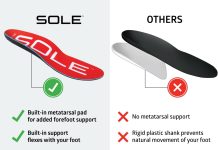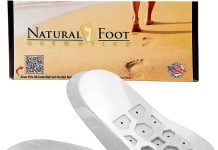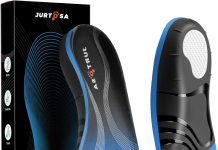Finding the right size for your insoles can be a perplexing task. They are too small, and they may be uncomfortable, causing unnecessary foot pain. They are too large, and they may not provide the support and stability you need.
In this article, we explore the secrets to determining the perfect size for your insoles, ensuring maximum comfort and effective foot care. Get ready to step into a world of proper sizing and discover how to give your feet the love and support they deserve.
Factors to Consider
Foot Length and Width
When determining the right insole size, one of the most essential factors is the length and width of your feet. Measuring your foot length and width accurately will help you choose insoles that fit snugly and comfortably. It is crucial to have the correct measurements to ensure proper support and alignment for your feet.
Type and Style of Shoes
Different types and styles of shoes require different types of insoles. For example, athletic shoes may require a different type of insole than dress shoes or work boots. Additionally, the thickness and design of the shoe’s insole pocket should be considered when choosing the right size. It’s essential to find insoles that can comfortably fit into your desired footwear without compromising their functionality.
Activity Level
Consider your activity level when selecting the size of your insoles. If you engage in high-impact activities such as running or playing sports, you may require more cushioning and support. In contrast, if you have a more sedentary lifestyle, you may not need as much cushioning but can focus on finding a comfortable fit. Considering your activity level will help determine the appropriate size and type of insoles to meet your specific needs.
Arch Type
Understanding your arch type is crucial in choosing the correct insole size. Some people have high arches, while others have low or flat feet. The arch of your foot affects the way weight is distributed, which in turn affects your gait and overall foot comfort. By identifying your arch type, you can select the ideal insole size that provides the necessary support and alignment for your feet.
Measuring Your Feet
Use a Brannock Device
When measuring your feet for insoles, using a Brannock Device is an efficient and accurate method. This device provides measurements for both length and width, allowing you to determine the appropriate insole size. A Brannock Device is commonly found at shoe stores and helps ensure you get precise measurements for a better fit.
Measure Both Feet
It’s essential to measure both feet when determining the correct insole size. Many people have slightly different foot sizes, with one foot being slightly larger than the other. By measuring both feet, you can choose insoles that accommodate the size of your larger foot, ensuring comfort and proper support for both feet.
Measure at the End of the Day
To get the most accurate measurements, it is recommended to measure your feet at the end of the day. Feet tends to swell slightly throughout the day due to regular activities and standing. Measuring your feet when they are at their largest ensures that the insoles you choose will accommodate any swelling, providing a comfortable fit throughout the day.
Consider Socks
When measuring your feet for insoles, you must consider the type of socks you typically wear. The thickness and material of your socks can impact the overall fit of your insoles. If you often wear thick socks, you may need slightly larger insoles to accommodate the extra volume. Conversely, if you usually wear thin socks, you may opt for slightly smaller insoles. It’s essential to measure your feet while wearing the socks you intend to wear with your insoles for the most accurate sizing.
Choosing the Right Size
Match Insole Size With Shoe Size
A general rule of thumb when choosing insoles is to select the same size as your shoe size. Insole sizes are typically labeled to correspond with standard shoe sizes. This ensures that the insoles are designed to fit comfortably within the shoe’s sizing parameters. However, remember that different shoe brands may have slight variations in sizing, so it’s always a good idea to try on insoles and shoes together to ensure a proper fit.
Consider Personal Preference
While matching your insole size to your shoe size is a good starting point, personal preference plays a significant role in choosing the right size. Some individuals prefer a snug fit that molds to their feet, while others prefer more room for added comfort. Consider your preferences and the space you want within your shoes when deciding on the appropriate insole size.
Leave Room for Toes
When selecting insoles, it is vital to leave some room for your toes. Your toes should not feel cramped or restricted while wearing insoles. An adequate toe room ensures proper circulation and helps prevent discomfort or foot conditions such as blisters or calluses. Choose insoles that allow your toes to move and splay naturally within your shoes.
Avoid Overcrowding
While it’s important to leave room for your toes, it’s equally important to avoid overcrowding the shoe’s interior by using oversized insoles. Overcrowding can lead to discomfort, blisters, and even foot pain. Select the appropriate size of insoles that seamlessly fit within your shoe without causing overcrowding or altering the intended fit of the footwear.
Types of Insoles
Full-Length Insoles
Full-length insoles extend from the heel to the toe, providing complete coverage and support for the entire foot. This type of insole is ideal for individuals who require maximum cushioning and support throughout their whole foot. Full-length insoles are commonly used in athletic shoes and work boots, where impact absorption and foot stability are crucial.
Three-Quarter Length Insoles
Three-quarter insoles cover the heel and the arch, providing support and cushioning to most of the foot. These insoles are particularly suitable for individuals looking for arch support or heel pain relief. They are often used in casual or dress shoes, where additional cushioning or arch support may be required without wholly occupying the shoe’s interior space.
Arch Support Insoles
As the name suggests, arch support insoles are designed to support the foot’s arch. They are typically made from more rigid materials and offer targeted support to alleviate arch-related discomfort or foot conditions such as plantar fasciitis. Arch support insoles are available in various shapes and sizes to cater to different arch types and shoe styles.
Cushioning Insoles
Cushioning insoles focus on providing extra cushioning and shock absorption to enhance overall comfort. They are typically made from softer materials such as gel or foam. They are especially beneficial for individuals who spend long hours on their feet or engage in high-impact activities. Cushioning insoles are versatile and can be used in various shoe types to improve overall foot comfort.
Customized Insoles
Benefits of Customized Insoles
Customized insoles offer a personalized fit and support tailored to your unique foot shape and needs. They can provide optimal arch support, cushioning, and alignment, which can alleviate foot pain, improve posture, and enhance overall foot health. Customized insoles are particularly beneficial for individuals with specific foot conditions or those seeking a higher level of comfort and support.
Professional Foot Assessment
Obtaining customized insoles typically involves a professional foot assessment. Qualified specialists or podiatrists use various techniques, such as gait analysis or 3D foot scanning, to assess your foot structure, arch type, and biomechanics. This comprehensive evaluation helps determine the specifications required for your customized insoles, ensuring optimal fit and support.
Orthotics vs. Custom Insoles
It’s important to differentiate between custom insoles and orthotics. While orthotics are also customized foot supports, they are usually prescribed for individuals with more severe foot conditions or structural abnormalities. Orthotics often involve more complex designs and advanced features to address specific foot issues. Custom insoles, on the other hand, focus on providing personalized support and comfort for individuals without severe foot conditions.
Cost and Availability
Customized insoles can be more expensive than over-the-counter insoles due to the personalized assessment and manufacturing process involved. The cost may vary depending on the complexity of the customization and the materials used. The availability of customized insoles can also vary, as they are often obtained through specialty footwear stores, podiatrists, or orthotic clinics. It’s essential to research local resources and consult with professionals to determine the options and costs available in your area.
Common Insole Sizing Issues
Insole Too Small
Choosing insoles that are too small can lead to discomfort and inadequate support. The insole may not cover the entire foot adequately, causing areas of the foot to lack proper cushioning or support. This can result in foot pain, blisters, or other foot conditions. It’s crucial to ensure the insoles you choose provide full coverage and support for your entire foot.
Insole Too Large
Insoles that are too large can also cause discomfort and potential foot problems. They may not fit securely within the shoe and can shift or move around. This can result in an unstable fit, blisters, or difficulties in walking or running. Selecting insoles that are the correct size, with a snug fit that doesn’t overcrowd the shoe, is essential for optimal comfort and support.
Insole Slipping or Moving
If your insoles slip or move while in use, it can cause significant discomfort and affect your gait and overall foot function. Insoles that don’t stay in place can lead to blisters and calluses or even contribute to foot fatigue. Properly sizing your insoles and ensuring they fit securely within your shoes can help prevent slipping or movement, allowing for a more comfortable and stable fit.
Insole Crowding Toes
Insoles that crowd the toes can lead to discomfort, restricted movement, and potential foot conditions such as blisters or calluses. It is crucial to choose insoles that provide adequate toe room, allowing your toes to move and splay naturally. Avoid insoles that press against the sides or tops of your toes, as this can lead to foot pain and discomfort.
Tips for a Proper Fit
Try Different Sizes
If you’re unsure about the appropriate insole size, it’s recommended to try different sizes to find the best fit. Different brands or models of insoles may have slight variations in sizing, so it’s essential to experiment with different options. Take your time to try on various sizes and assess their comfort and fit within your shoes.
Trim if Necessary
In some cases, insoles may be slightly longer or wider than your shoe’s size, requiring some trimming to achieve a perfect fit. If your insoles are too long, you can trim them at the toe area using scissors. Similarly, if your insoles are too wide, you can trim the sides to match the width of your shoes. It’s essential to follow the manufacturer’s guidelines and instructions when trimming insoles to avoid damaging them.
Seek Professional Help
If you’re uncertain about the correct insole size or have specific foot concerns, seeking professional help from a podiatrist or footwear specialist is recommended. They can provide expert advice, perform a thorough foot assessment, and guide you in selecting the appropriate size and type of insoles for your specific needs. Professional assistance can ensure that you make the best choice for your foot health and comfort.
Replace Insoles Regularly
Over time, insoles can lose their cushioning and support capabilities, affecting their overall effectiveness. To maintain optimal foot comfort and support, it’s essential to replace insoles regularly. The lifespan of insoles can vary depending on usage, activity level, and individual preference. As a general guideline, it’s recommended to replace insoles every six to twelve months or if they show signs of wear and tear.
Potential Foot Problems
Blisters and Calluses
Ill-fitting or improperly sized insoles can contribute to the development of blisters and calluses. When insoles are too small, large, or overcrowded, friction and pressure points can occur, leading to painful blisters and calluses. By selecting the correct insole size and ensuring a proper fit, you can minimize the risk of developing these common foot problems.
Arch and Heel Pain
Choosing the wrong size or type of insoles can exacerbate arch and heel pain. Inadequate arch support or improper cushioning can strain the arches and heels, leading to conditions such as plantar fasciitis or heel spurs. By selecting insoles that provide the necessary arch support and cushioning for your foot type and activities, you can help alleviate or prevent arch and heel pain.
Foot Fatigue
Insoles not providing sufficient cushioning or support can contribute to foot fatigue. This can manifest as tiredness or achiness in the feet after prolonged periods of standing or walking. By selecting insoles that offer proper shock absorption and support, you can reduce foot fatigue and enhance overall foot comfort, even during extended periods of activity.
Foot Conditions
Certain foot conditions, such as flat feet, high arches, or plantar fasciitis, require specific types of insoles to address the unique needs associated with these conditions. Using improperly sized or unsuitable insoles can worsen these conditions or fail to provide the necessary support and relief. Consult with a healthcare professional or podiatrist to determine the appropriate insole size and type to manage any existing foot conditions effectively.
When to Consult a Specialist
Persistent Foot Pain
If you experience persistent foot pain that does not improve with properly fitted insoles or over-the-counter solutions, it’s essential to consult a healthcare professional or podiatrist. Persistent foot pain may be a sign of underlying foot conditions or structural abnormalities that require specialized treatment or orthotics. A specialist can comprehensively assess and develop a tailored plan to address your foot pain concerns.
Foot Abnormalities
Individuals with foot abnormalities, such as clubfoot, bunions, or structural deformities, may require specialized insoles or orthotics to support and align the feet properly. In these cases, a healthcare professional or podiatrist can assess the specific foot abnormalities and create customized insoles or recommend appropriate orthotic devices. Seeking professional help ensures the insoles adequately address any unique foot abnormalities or conditions.
Diabetes or Circulation Problems
Individuals with diabetes or circulation problems should exercise extra caution when choosing insoles and footwear. Poorly fitting insoles can increase the risk of foot ulcers, infections, and other severe complications for those with diabetes or circulation issues. Consultation with a healthcare professional is essential in these cases to select insoles that prioritize foot protection, proper circulation, and overall foot health.
Injury or Surgery Recovery
After a foot injury or surgery, choosing the correct insole size and type is vital for recovery and rehabilitation. In some cases, specialized insoles may be prescribed to provide optimal support, cushioning, and stability during the healing process. A healthcare professional or orthopedic specialist can guide you in selecting the appropriate insoles that aid recovery and promote a safe and efficient healing process.
Conclusion
Choosing the right insole size ensures optimal foot comfort, support, and overall foot health. Factors such as foot length and width, shoe type, activity level, and arch type should be considered when determining the appropriate insole size. By measuring your feet accurately, considering personal preferences, and being aware of common sizing issues, you can select insoles that offer the perfect fit for your specific needs.
Whether opting for off-the-shelf insoles or customized solutions, prioritize obtaining the correct size to prevent foot problems, enhance comfort, and support your feet throughout daily activities. Consult with professionals when needed, replace insoles regularly, and seek expert advice for persistent foot pain or specific foot conditions. With the right insole size, you can take confident steps toward optimal foot health and overall well-being.


